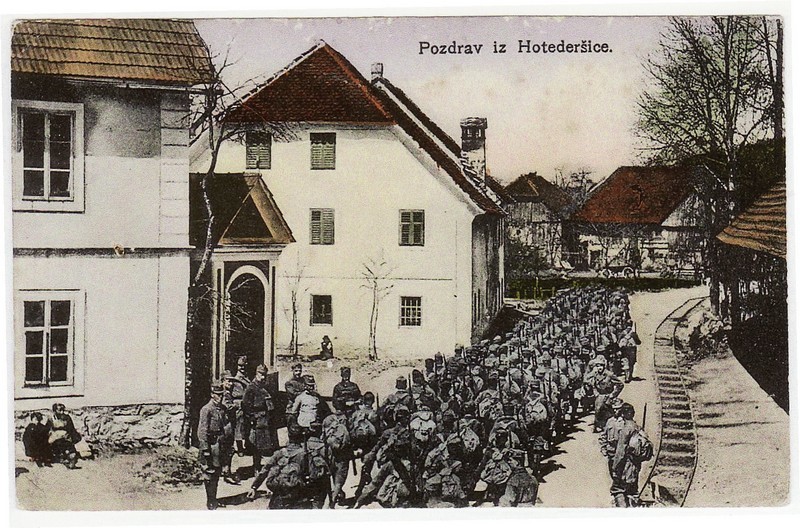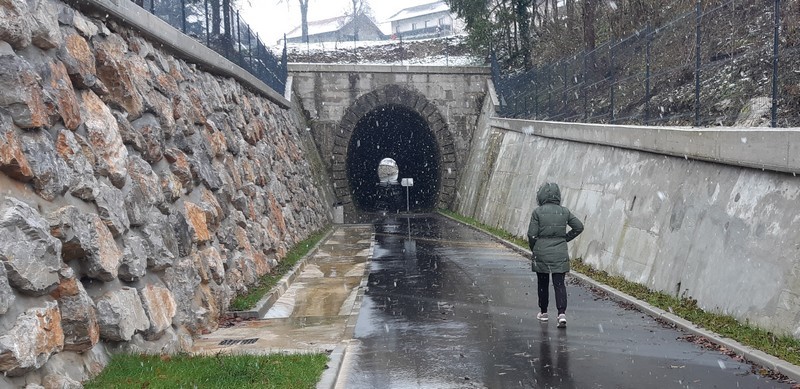
Začetek I. svetovne vojne
Prvo svetovno vojno je sprožil uboj avstro-ogrskega prestolonaslednika Franca Ferdinanda 28. junija 1914 (Vidov dan) v Sarajevu. Zaradi tega je Avstro-Ogrska 23. julija 1914 izročila Srbiji ultimat, v katerem je med drugim zahtevala preiskavo atentata. Srbija se s predlogom ni strinjala kar je Avstro-Ogrska izrabila kot razlog, da je 28. julija 1914 Srbiji napovedala vojno, ki se je razrasla v 1. svetovno vojno.
Zaledje soške fronte – pomen Logatca
Za oskrbo Avstro – Ogrske vojske na soški fronti je moralo skrbeti zaledje od Trsta, Postojne, Vipave, Logatca, Godoviča, Idrije, Trnovskega gozda Banjške planote in vse do Bohinja.
Ker je železniška proga Jesenice Gorica potekala skozi fronto za oskrbo ni bila primerna. Tako je postal Logatec, ki leži ob železniški porogi Dunaj Trst glavna oskrbovalna postaja. Tu je bilo v skladiščih vsega kar je bilo potrebno za bojišče: hrana, sanitetni material, orožje, …
Za prevoz opreme in vojakov iz Logatca proti Črnemu Vrhu so na hitro postavili poljsko železnico (feldban), ki je v glavnem potekala kar po obstoječi cesti. Na Poštnem vrtu (v bližini trgovine Mercator sredi Logatca) so bila glavna skladišča. Tam so blago nalagali na vagončke ki so jih s konjsko vprego vozili proti fronti. Kompozicije so bile sestavljene iz 10-ih vagončkov, ki so jih vlekli po štirje konji. Pri tem je sodelovalo je čez 5.000 konj. Leta 1917 so konje zamenjali dizelski motorji. V nočnem času so prevažali material za fronto, nazaj pa so vozili ranjence.

Odločitev za izgradnjo normalnotirne železnice
Leta 1916, po deveti ofenzivi, se je morala avstro-ogrska vojska umakniti na višje položaje proti Čepovanu in Trnovski planoti. Vojaško poveljstvo, ki je imelo svoj štab v Gorenjem Logatcu, je zahtevalo takojšnjo zgraditev normalnotirne železniške proge iz Logatca na Črni vrh. Na izbrani trasi so najprej začeli z vrtanjem tunelov v Logatcu in v Godoviču. Na trasi je delalo kar 20.000 ujetnikov različnih narodnosti: Rusov, Italijanov, Bosancev in drugih.

Odsek Logatec – Kalce je bil najtežji
Celotna trasa je bila razdeljena na tri odseke s skupno dolžino 25km. Najbolj zahteven je bil odsek Logatec - Kalce, predvsem zaradi priklopa na železniško progo Dunaj Trst. Težavo so rešili z velikim nasipom, ki se je v širokem loku spustil z višje ležeče južne železnica na Logaško polje od tam naprej pa skozi tunel pod Naklom in mimo Lokve priti Kalcam. Najbolj zahteven poseg je bil izgradnja 180m dolgega predora pod Naklom. Delo je ovirala voda, za katero so uredili poseben drenažni sistem. Med kopanjem tunela so naleteli na plast črnega premoga, ki so ga deloma porabili za lokomotivo, ki je odvažala izkopani material, deloma pa so ga lahko porabili domačini za kurjavo.
Za odvoz materiala iz tunela so postavili ozkotirno železnico, s katero so odvažali material na nasip pod Sekirico. Za vleko so uporabljali parno lokomotivo, ki so jo delavci imenovali "mašinka".
Predor je bil končan v začetku leta 1917. Ker je bilo 28. oktobra 1917 konec soške fronte, skozi tunel vlak ni nikoli zapeljal.
Tunel med II. sv. vojno in danes
Tunel je med drugo svetovno vojno služil kot zaklonišče za prebivalce Logatca. V ta namen so bile sezidane opečnate predelne stene, ki so preprečevale močan prepih. Po vojni pa je bilo v njem tudi skladišče goriva.
Leta 2017 je občina Logatec začela z obnovitvenimi deli, ki še niso končana. Zato je tunel uradno še vedno zaprt.

Tunel pred obnovo (zgoraj) in po obnovi (spodaj).

Mašinka (locomotive) in the tunnel under Naklo
The beginning of World War I
World War I was triggered by the assassination of the Austro-Hungarian heir to the throne Franz Ferdinand on June 28, 1914 (Vid's Day) in Sarajevo. Because of this, on July 23, 1914, Austria-Hungary delivered an ultimatum to Serbia, in which, among other things, it demanded an investigation into the assassination. Serbia did not agree with the proposal, which Austria-Hungary used as a reason to declare war on July 28, 1914, which escalated into World War I.
The hinterland of the Soča front - the importance of Logatac
The hinterland from Trieste, Postojna, Vipava, Logatac, Godovič, Idrija, Trnovski gozd, Banjška planota and all the way to Bohinj had to take care of the supply of the Austro-Hungarian army on the Soča front.
Since the Jesenice - Gorica railway line ran through the front, it was not suitable for supply. Thus, the Logatec post office, which is located next to the Vienna-Trieste railway line, was the main supply station. Everything needed for the battlefield was stored here: food, medical supplies, weapons,...
To transport equipment and soldiers from Logatac to Črni Vrh, a railway (feldban) which mainly ran along the existing road, was quickly built. The main warehouse was located in Poštni vrt (near the Mercator store in the center of Logatac). There, goods were loaded onto small wagons, which were driven by horse-drawn carriages towards the front. The compositions consisted of 10 wagons pulled by four horses. More than 5,000 horses participated in this. In 1917, diesel engines replaced horses. At night, they transported material to the front, and transported the wounded back.
The decision to build a normal railway
In 1916, after the ninth offensive, the Austro-Hungarian army had to retreat to a higher position towards Čepovan and Trnovska planota. The military command, which had its headquarters in Gorenji Logatec, demanded the immediate construction of a standard-gauge railway line from Logatec to Črni vrh. On the selected route, they first started drilling tunnels in Logatec and Godovič. As many as 20,000 prisoners of various nationalities worked on the route: Russians, Italians, Bosnians and others.
The Logatec - Kalce section was the most difficult
The entire route was divided into three sections with a total length of 25 km. The section Logatec - Kalce was the most demanding, before connecting to the Vienna Trieste railway line. The problem was solved with a large embankment, which descended in a wide arc from the higher-lying southern railway to Logaško polje, and from there through the tunnel under Naklo and past Lokve to reach Kalce. The most demanding intervention was the construction of a 180m long tunnel under Naklo. The work was hindered by water, for which a special drainage system was arranged. While digging the tunnel, they came across a layer of black coal, which was partly used for the locomotive that transported the excavated material, and partly used by the locals for firewood.
A narrow-gauge railway was built to transport the material from the tunnel, which was used to transport the material to the embankment below Sekirica. For traction, they used a steam locomotive, which the workers called "Mašinka".
The tunnel was completed at the beginning of 1917. Since the Soča front was over on October 28, 1917, a train never went through the tunnel.
The tunnel between II. St. war and today
During World War II, the tunnel served as a shelter for the residents of Logatac. Brick partitions were built to prevent strong drafts. After the war, it was also used as a fuel warehouse.
In 2017, the municipality of Logatec started renovation works, which have not yet been completed. Therefore, the tunnel is officially still closed.